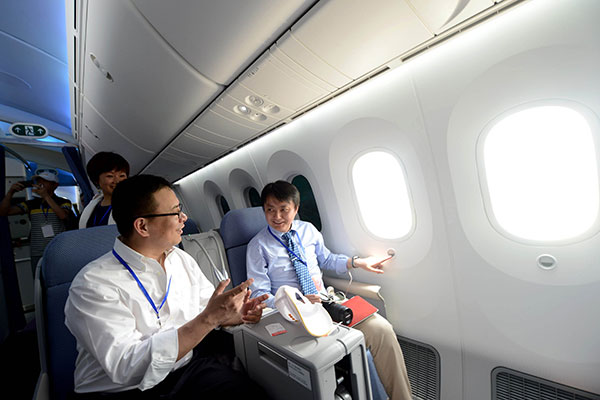Post-80s and 90s first-class passengers surging in China
Updated: 2016-05-06 16:47
By Ruan Fan(chinadaily.com.cn)
|
||||||||
 |
|
The first Boeing B787 airplane in China lands on White Cloud Airport in Guangzhou, on June 2, 2013. [Photo/VCG] |
China's post-80s and 90s have surpassed the 70s to become the major force of first-class and business-class passengers, and the number is still growing, according to the first season report issued by Ctrip on Wednesday.
The report shows that among these two kinds of seats takers, those born in 80s account for 28 percent of the total seat, over that of the 70s, which is 27 percent.
The post-90s generation, though making up only 9 percent of the total number, sees a steady slow rise from 2014's 6 percent and 2015's 7.5 percent.
As to the gender distribution, the report shows that first-class male passengers exceed that of the opposite sex by 40 percent, making up over two-thirds of the total number.
It is notable, however, that the figures might vary taking into consideration data from all the airlines. The result varies from a 2014 survey done by Guangzhou Daily, for example, shows that post-80s females, aged between 25 and 35, take 35.94 percent of the first and business class, while their male peers make up only 17.36 percent.
The younger trend taking place in China, as some industry experts analyze, results primarily from the growing number of post-80s replenishing executive and managerial positions in the society.
Another contributing factor is that airline companies are introducing special offers for hot routes between major cities, namely, Beijing, Guangzhou, Shanghai and Chengdu.
Take June 6 flight of FM9018, special offer of first class is 1,300 RMB (about $199), only slightly higher than the full price of economic class, and a 66 percent discount of the full price of first class.
Changes behind the seat takers and the more affordable prices, as airline leaders observe, also reflect the strategic adjustments resounding the nation's curb on three public consumptions.
"It was a rigid demand for most first-class and business-class passengers, the price was not a problem," a domestic airline marketing department officer told First Financial Daily. He said that now airlines are trying to promote "value first-class seats" to compete for such a group.
Budget airlines are also joining traditional airlines to earn a piece of the pie. As Spring Airlines CEO Wang Zhenghua said, the company has seen a continuous rise of "economic business-class" seats.
"Economic business class" offers passengers an in-between choice, with seats 20-40 percent more spacious than economic class, and the price 70-90 percent of the full price.
- Inspection teams to cover all of military in anti-corruption drive
- Tornado, heavy rain batters Central China's Hunan
- Beijing to cut downtown population this year
- Palace Museum confirms ancient relics find
- Disney promises ‘safe, pleasing service of high quality’
- Couple detained for selling their two sons
- Rousseff: Accusations against her 'untruthful'
- Almost one-sixth of Brazil's confirmed microcephaly cases linked to Zika
- Impeachment trial against Rousseff recommended to senate
- With nomination secured, Trump to aim all guns at Hillary Clinton
- Obama sips Flint water, urges children be tested for lead
- Massive protests against Abe mark Japan's Constitution Memorial Day

 Raging wildfire spreads to more areas in west Canada
Raging wildfire spreads to more areas in west Canada
 World's first rose museum to open in Beijing
World's first rose museum to open in Beijing
 Teapot craftsman makes innovation, passes down techniques
Teapot craftsman makes innovation, passes down techniques
 Top 8 iOS apps recommend for mothers
Top 8 iOS apps recommend for mothers
 Five things you may not know about the Start of Summer
Five things you may not know about the Start of Summer
 Art imagines celebrities as seniors
Art imagines celebrities as seniors
 Japanese animator Miyazaki's shop a big hit in Shanghai
Japanese animator Miyazaki's shop a big hit in Shanghai
 Star Wars Day celebrated around world
Star Wars Day celebrated around world
Most Viewed
Editor's Picks

|

|

|

|

|

|
Today's Top News
Liang avoids jail in shooting death
China's finance minister addresses ratings downgrade
Duke alumni visit Chinese Embassy
Marriott unlikely to top Anbang offer for Starwood: Observers
Chinese biopharma debuts on Nasdaq
What ends Jeb Bush's White House hopes
Investigation for Nicolas's campaign
Will US-ASEAN meeting be good for region?
US Weekly

|

|







